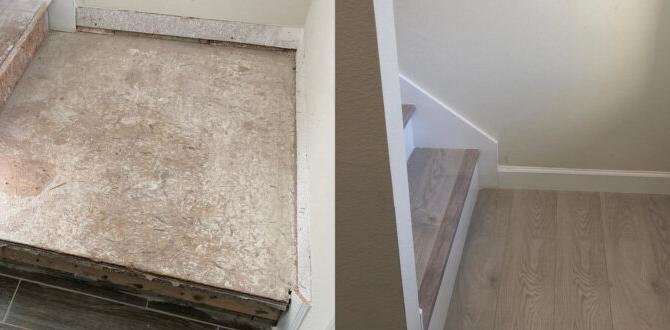Quick Summary: Get your nailer firing reliably again! This guide offers easy fixes for common nail gun issues, from air pressure and jam-ups to driver blade problems, ensuring consistent firing for smooth project completion.
Hey there, fellow DIYers and woodworking fans! Jack Shaffer here, your go-to guy for all things nailers. Ever get that frustrating moment when your trusty nail gun just… stops? One minute it’s driving nails like a champ, and the next it’s sputtering, jamming, or just plain refusing to fire. It’s a common hiccup, but don’t let it derail your project! In this guide, we’ll walk through the most common reasons your nail gun might be acting up and, more importantly, how to fix it. We’ll keep it simple, straightforward, and safe, so you can get back to building with confidence. Let’s dive into some essential nail gun troubleshooting for consistent firing!
We’ll cover everything from simple pressure checks to deeper dives into the mechanics of your tool. You’ll learn how to identify the problem and implement a quick fix, saving you time and a whole lot of aggravation. By the end of this, you’ll be a nail gun troubleshooting pro!
Table of Contents
Understanding Nail Gun Types and How They Work
Before we dive into troubleshooting, it’s super helpful to know a little about how your nail gun works. Most DIYers will be dealing with one of three main types:
- Pneumatic (Air-Powered) Nail Guns: These are the workhorses. They run off compressed air from an air compressor. An air hose connects them to the compressor, which provides the power. They’re powerful, efficient, and generally require less maintenance.
- Cordless (Battery-Powered) Nail Guns: These are super convenient because they don’t need an air hose. They use a battery for power and often have a small gas cartridge or an internal mechanism to drive the nail. Great for portability.
- Electric (Corded) Nail Guns: These plug directly into a wall outlet. They are good for lighter tasks and don’t require an air compressor or batteries, making them simple to use if you have access to power.
Regardless of the type, the basic principle is the same: something (air, battery, or electricity) powers a mechanism to drive a piston, which then strikes the head of a nail, driving it into your material. When this process is interrupted, we get those dreaded firing issues.
The Usual Suspects: Common Causes of Inconsistent Nail Gun Firing
Don’t worry, most nail gun firing problems aren’t mysteries from a lost tomb! They’re usually down-to-earth issues that we can easily fix. Let’s break down the most frequent culprits:
1. Air Pressure and Supply Issues (Pneumatic Nailers)
This is the number one reason pneumatic nailers misbehave. Think of compressed air like the fuel for your nail gun. Not enough fuel, and it won’t run right!
- Low Air Pressure: Your air compressor might not be pumping enough air into the tank, or the regulator on the compressor might be set too low.
- Kinked or Leaking Air Hose: A crushed, kinked, or leaking air hose restricts the flow of air to the gun, much like trying to drink through a bent straw.
- Loose Connections: The coupler connecting the hose to the nail gun, or the hose to the compressor, might not be securely fastened, leading to air leaks.
- Wrong Air Pressure Setting: Every nail gun has an optimal operating pressure range. If it’s set too high, you can damage the gun or your workpiece. If it’s too low, nails won’t drive properly. Check your nail gun’s manual! It’s usually found on a label on the tool itself or in the user guide. For instance, many framing nailers might need 80-120 PSI, while brad nailers might only need 60-100 PSI. Following the Occupational Safety and Health Administration (OSHA) guidelines for compressed air safety, including proper pressure settings, is always a good idea.
2. Nail Feeding and Jamming
This is probably the most visible problem. When nails don’t feed correctly or get stuck, the gun won’t fire – or it’ll fire awkwardly.
- Incorrect Nail Size or Type: Using nails that are too long, too short, the wrong gauge (thickness), or the wrong head style for your specific nailer is a recipe for jams. Always use the nails recommended by the manufacturer. For example, a finish nailer designed for 16-gauge nails will jam if you try to force 15-gauge nails into it.
- Bent or Damaged Nails: Even a slightly bent nail can cause a jam. Inspect your nails for any damage before loading them.
- Dirty Magazine: The channel where the nails sit can accumulate sawdust, glue, or debris. This can prevent nails from sliding smoothly into the firing position.
- Improper Loading: If the nails aren’t seated correctly in the magazine, they won’t feed properly. Make sure the nail strip is aligned and the magazine cover is securely closed.
- Worn Feed Pawl: This small part helps advance each nail. If it’s worn or damaged, it might not grab the next nail, leading to feeding issues.
3. Driver Blade and Piston Problems
The driver blade is the part that actually strikes the nail. The piston is what drives the blade. If these aren’t working smoothly, you’ll have problems.
- Bent or Dull Driver Blade: A damaged blade can bend nails as it strikes or fail to strike them squarely, leading to jams or incomplete drives.
- Worn O-rings and Seals: These small rubber parts create seals within the tool. If they wear out, the gun can lose power, leading to nails not sinking fully or not firing. They can also cause air leaks.
- Lack of Lubrication (Pneumatic): As mentioned, pneumatic tools need oil to keep the piston and cylinder moving freely. Dry operation leads to wear and can cause the piston to stick.
- Dirt and Debris: A buildup of sawdust or grime inside the tool can impede the movement of the driver blade and piston.
4. Contact Trip Mechanism Issues
This is the part of the nail gun that you press against your workpiece. It tells the gun to fire.
- Stuck Contact Trip: If the contact trip gets jammed with debris or is bent, it won’t depress properly, preventing the gun from firing.
- Dirty or Worn Springs: Like any moving part, the springs that power the contact trip can get gummed up or lose their tension over time, leading to sluggish operation.
5. Battery and Power Issues (Cordless Nailers)
For cordless tools, the battery is everything!
- Low Battery Charge: It sounds obvious, but a battery that’s not fully charged won’t have enough power to drive nails effectively, or even to fire at all.
- Dead or Aging Battery: Batteries have a lifespan. If yours is old, it might not hold a charge well or provide consistent power.
- Dirty Battery Contacts: Just like any electrical connection, the contacts on the battery and the tool can get dirty, obstructing the flow of power.
- Gas Cartridge Issues (if applicable): Some cordless nailers use small disposable gas canisters. If the cartridge is empty or not seated correctly, the gun won’t fire.
Your Step-by-Step Nail Gun Troubleshooting Guide
Alright, let’s get practical! When your nail gun misbehaves, follow these steps. Safety first, always!
Step 1: Safety First – Disconnect the Power!
This is non-negotiable. Before you do anything else, make sure the gun can’t accidentally fire.
- Pneumatic: Disconnect the air hose from the nail gun.
- Cordless: Remove the battery pack.
- Electric: Unplug the tool from the power source.
It’s also a good habit to wear safety glasses throughout this process, as small parts can sometimes jump unexpectedly.
Step 2: Check the Basics (Pneumatic Nailers)
Let’s start with the air supply.
Check Air Pressure:
- Turn on your air compressor and let it build up to its set pressure.
- Check the regulator on your compressor. What PSI is it set to?
- Now, check the regulator on your nail gun (if it has one) or the gauge at the compressor if you’re using a basic setup.
- Compare this to your nail gun’s recommended operating range (check its manual!). Most framing nailers need 80-120 PSI, while finish, brad, or pin nailers might need less.
- If the pressure is too low, increase it. If it’s too high, decrease it.
Inspect Air Hose and Connections:
- Visually inspect the entire length of your air hose for visible damage, kinks, or holes.
- Ensure the quick-connect coupler on the nail gun is securely attached and not leaking air when the compressor is running. Listen for hissing.
- Check the connection at the compressor as well.
Reconnect and Test Lightly:
- Reconnect the air hose to the nailer.
- Gently press the contact trip against a scrap piece of wood. Does it feel smooth? Does the gun try to fire?
Step 3: Check the Basics (Cordless and Electric Nailers)
These are generally simpler, but power is key.
Check Battery Charge (Cordless):
- Ensure the battery is fully charged. Most batteries have indicator lights.
- If the battery is old or seems weak, try a different, fully charged battery if you have one.
- Check the battery contacts on both the battery and the tool for dirt or corrosion. Clean them with a dry cloth or contact cleaner if necessary.
Check Power Cord (Electric):
- Ensure the power cord is securely plugged into both the wall outlet and the tool.
- Inspect the cord for any damage.
- Try a different outlet to rule out an issue with your power source.
Model-Specific Features:
- For cordless models with gas cartridges, ensure a new cartridge is correctly installed if you suspect that’s the issue.
Step 4: Inspect the Magazine and Nails
This applies to all nailer types and is a very common fix.
Open the Magazine:
- Make sure the tool is disconnected from its power source (air or battery).
- Locate the magazine release or latch and open the magazine follower.
- Pull back the follower to access the nails.
Check for Jams and Debris:
- Look inside the magazine. Is there a nail bent or jammed?
- Carefully try to remove any jammed nails. Pliers might be helpful, but be gentle.
- Clean out any sawdust, glue residue, or other debris that might be preventing smooth nail movement using a dry cloth or a small brush. A blast of compressed air can also help remove dust.
Inspect Nails:
- Are you using the correct type and size of nails recommended for your tool? Consult your manual! Family Handyman offers a good overview of nail types, which can help you identify the correct specifications.
- Examine the nail strip for any bent or damaged nails. Remove them.
- Ensure the nails are loaded correctly, sitting flat against the magazine base and aligned properly.
Close and Reload:
- Once clear and clean, slide the follower back and close the magazine securely.
- Load a fresh strip of the correct nails.
- Reconnect the power source cautiously.
Step 5: Check the Contact Trip and Nosepiece
This is the part that contacts your wood. It needs to move freely.
Frequently Asked Questions About Nail Gun Firing Issues
Why is my nail gun not firing at all?
This can happen for several reasons. Check your air pressure – it might be too low. Ensure the nose of the nailer is pressed firmly against the surface you’re nailing. Also, verify that the safety mechanism isn’t engaged and that you have nails loaded correctly. Finally, inspect for any jams.
My nail gun is firing, but the nails aren’t fully sinking. What’s wrong?
If nails aren’t sinking all the way, it’s usually an air pressure issue; you might need to increase it. Another common cause is wear on the driver blade or the o-rings and seals within the gun, which can reduce driving power. Ensure the contact trip (the part that touches the wood) is moving freely and isn’t obstructed.
How often should I lubricate my nail gun?
For pneumatic nailers, a few drops of specialized pneumatic tool oil in the air inlet after each day’s use or every few hours of heavy use is generally recommended. Cordless and electric models often have sealed mechanisms, but always consult your tool’s manual for specific lubrication requirements. Over-oiling can sometimes cause issues, so follow manufacturer guidelines.
What is a nail jam, and how do I fix it?
A nail jam occurs when a nail gets bent or stuck inside the nail gun’s mechanism. To fix it, always disconnect the air supply (for pneumatics) or remove the battery (for cordless). Carefully open the nose of the gun, find the jammed nail, and use pliers or a similar tool to gently remove it. Avoid forcing anything, as you could damage the gun.
Can inconsistent nail depth be a sign of a serious problem?
Sometimes, yes. While low air pressure or minor adjustments can cause inconsistent depth, persistent issues might point to problems with internal seals, worn-out springs, or a damaged driver blade. If simple troubleshooting doesn’t resolve it, it’s best to have the tool professionally inspected or consider a repair kit.
My nail gun jams frequently. What causes this?
Frequent jamming can stem from using the wrong size or type of nails for your gun. Ensure your nails are the correct gauge and length for your specific nailer model. Other causes include a dirty magazine, a bent or damaged driver blade, or insufficient air pressure, which doesn’t drive the nail with enough force. A damaged feed pawl can also cause feeding issues.
Is it safe to repair my own nail gun?
For basic issues like clearing jams, checking air lines, or replacing simple parts like o-rings (if you’re comfortable and have the right manual), DIY repair can be safe and cost-effective. However, for complex internal issues, it’s often best to consult the manufacturer’s service manual or take it to a qualified repair shop to avoid further damage or personal injury. Always prioritize safety and disconnect power sources before any work.




